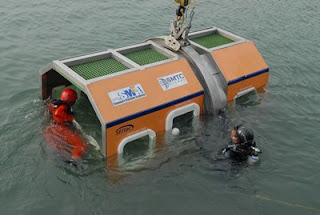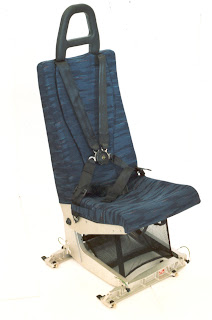H.U.E.T.
Helicopter Underwater Escape TrainingSo the final chapter of my Scotland '08 Legacy is centered around H.U.E.T. Not to be confused with Huey, Uncle Scrooge's Nephew and doppleganger to Dewey and Louie.

H.U.E.T. is Helicopter Underwater Escape Training. As was previously mentioned in an earlier post, a large part of my work will be in the North Sea. All rigs are only accessible by helicopter. In fact, from the Aberdeen Heliport in North Scotland, over 100,000 helicopter round trips are flown each year.

Because of the frequency of such flights, it is a requirement that anyone who is to fly out there, must be certified in emergency response.
So inside of our training school, they have a large (unheated) swimming pool. They have a mock helicopter fuselage, and plenty of practice tossing said fuselage into the pool.

We were trained in two different types of escape. The first was just holding your breath. The second involved an apparatus called a re-breather.
Anytime that you are on a helicopter in the North Sea, you must be buckled in with a 4-point harness.

With that said, here are the basic steps of escape:
1 - Holding Breath (Once you have been alerted that you are going down):
- Don't panic
- Tighten harness belts (you'll see why in a second)
- Locate your buckle with left hand and the window with your right hand (or vice versa if the window is to your left)
- Straighten back and put both feet flat on the ground
- Hang on
If you are using a re-breather, the only difference is inflating the air bladder after tightening the harness belts.
Once you hit the water, the most important thing to do is to wait until the helicopter has actually settled into sinking mode. There may be a few moments where the rotors are pitching and turning and you want to make sure that you will get clear of them.

Typically it is best if you wait until your entire body is under water. You then eject the window with your window hand FIRST and then flip the quick-release on your harness with your other hand. Remember tightening it down? Well, they are designed to release more quickly when there is more tension on them. So, the tighter you can get those straps, the quicker you are getting out.
Then, with your hand that located the window, you swim out. A word to the wise: Eject your window first...otherwise you have to fight your own buoyancy while trying to pop the window out.

Simple right?
Our training consisted of being tossed into the drink a total of 7 times. Sometimes we went in right-side up. Sometimes we were upside down. We were also tossed in pitched to one side. Sometimes we used the re-breather...sometimes, we were flying only on the air in our lungs. (I actually preferred that because the re-breather was really complicated.)
On my final dunking, I knew we were going in upside down, and I didn't use the re-breather. I remember going under, and just sitting there. I was strapped in, hanging upside down, underwater, and frozen in time. I wasn't panicking at all. It was actually quite calm. I just remember sitting there and soaking it all in that I was in Scotland...upside down, underwater, in a helicopter shell. It was surreal.
Anyway, I realized that I hadn't moved in a few moments and the trainers were probably going to come after me. So I popped, flipped, and surfaced with no problems.
I love my job.


 Because of the frequency of such flights, it is a requirement that anyone who is to fly out there, must be certified in emergency response.
Because of the frequency of such flights, it is a requirement that anyone who is to fly out there, must be certified in emergency response.
 With that said, here are the basic steps of escape:
With that said, here are the basic steps of escape:

 The blustery weather of yesterday takes me back to a time that I visited the enchanting country of Scotland.
The blustery weather of yesterday takes me back to a time that I visited the enchanting country of Scotland. 
